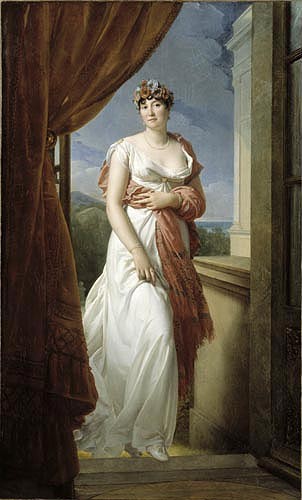More than any other period in the history of France, that of the Directory paved the way for certain emblematic women to make their mark and almost to become symbols of the renewed vigor of social life after the torments of the Revolution and particularly the Terreur. And the painter Gérard immortalised the most famous of them, namely, Josephine, the wife of the young General Bonaparte, Laure de Bonneuil – Madame Regnaud de Saint-Jean d'Angely -, Madame Récamier, and of course Madame Tallien, shown here, painted in 1804.
Thérésia Cabarrus (1773-1835) was born in Madrid, the daughter of a banker of French extraction François Cabarrus. Brought up in Paris, she married (aged 14) the Marquis de Fontenay, a libertine gambler, whom she left soon after. She then turned her attention to Tallien, whom she had met in Bordeaux where he had been sent on business by the Convention. She had such influence over the man who was to become her second husband that she managed to save many from the guillotine during the Terreur. This philanthropy later won her the nickname 'Notre-Dame de Thermidor' (Our Lady of Thermidor) or Notre-Dame des Bonsecours (Our Lady of Salvation). She was the 'it' girl of the Directory. As a close friend of Josephine's, she shared with her in the favours of the Director Paul Barras and then, at the beginning of 1799, began a liaison with the banker Ouvrard. Diverced from Tallien 1802, she married again in 1805, this time to the Comte de Caraman, soon to become the Prince de Chimay, whom she followed to Belgium during the Restoration. Her lively love-life was the target of Napoleon's disdain, and during the Consulate period he demanded that she behave more discreetly.
As the superb ambassadress of Parisian fashion, Madame Tallien was praised as much for her beauty as for her goodness. Gérard shows her here crowned with anemones, wearing a light antique-style robe (a fashion which she herself had championed during the Directory) covered with a red cashmire shawl setting off the whiteness of her shoulders and arms. On seeing her one day at the Opera, Talleyrand, noting her simple, white silk, sleeveless tunic (with clearly nothing whatsoever underneath it), remarked: “il n'est pas possible de s'exposer plus somptueusement” ('to display oneself more sumptuously than that would be impossible'). She was a buxom women, as Gérard painted her in 1804, but at that date the “belle Thérésia” had already had six children…
This portrait however is the one that has fixed her image for posterity. It was acquired by the Ville de Paris, on 16 April, 2001, at an auction in Bayeux, for six million, four hundred thousand Francs. To that date it had been held in the collection of the Château de Chimay.
Karine Huguenaud (tr. P.H.)
March 2005
Madame Tallien
Artist(s) : GERARD François (baron)

- Date :
- 1804
- Technique :
- oil on canvas
- Dimensions :
- H = 2.12 m, L = 1.27 m
- Place held :
- Paris, Musée Carnavalet
- Photo credit :
- © Photothèque des Musées de la Ville de Paris / Joffre

